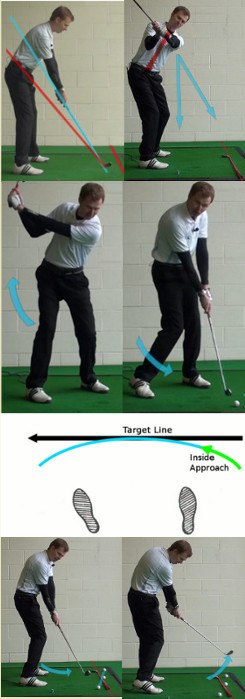
Has your golf swing gone flat? Are you hitting a lot of hooks, or perhaps pushing your shots? Catching the ball thin with your irons?
A so-called “flat” swing plane can cause these problems and more. A swing is considered flat when the left arm forms an angle of less than 45° with the ground at the top of the backswing (when viewed looking down the target line). In other words, it's more horizontal than vertical, the opposite of an “upright” swing.
To be sure, a flat swing isn't necessarily a bad thing. Just look at Matt Kuchar, one of the PGA Tour's leading lights. On the plus side, a flat swing helps you attack the ball with an inside-to-outside swing path, the key to hitting a draw. The shallow approach angle also decreases your chances of catching the ground first and hitting the ball fat.
That's the good news. The bad news is, an overly flat swing can result in ugly, damaging duck hooks, shots pushed way right and balls struck near the club's sole.
If you suffer from any of these issues, the first thing to do is check your swing plane in a mirror. Set up with any club, driver to mid-iron, with the mirror to your right. Swing to the top and stop. Does your left arm create an angle of less than 45° with the floor? The smaller the angle, the flatter your swing.
If you determine that your plane is excessively flat, here are a few easy fixes:
- Stand closer to the ball: If you're standing too far from the ball at address, you'll overextend the arms and create a swing path that's excessively “around” the body. Move an inch or two closer. This will put the club on a more upright arc and straighten those hooks.
- Here's a great tutorial on standing the correct distance from the ball: Address the Ball at the Perfect Distance (video)
- Straight back on the takeaway: Taking the club back too far inside the target line forces you into a flat position. Try this drill to check your takeaway, and repair it if needed:
- Place a clubhead cover or similar object 8” – 10” behind the ball, directly on the target line.
- Take the club back – do you hit the object squarely, clip it or miss it to the inside?
- Practice brushing the object straight away from the ball and letting the clubhead turn naturally to the inside.
To learn more about the golf swing plane, check out these links:
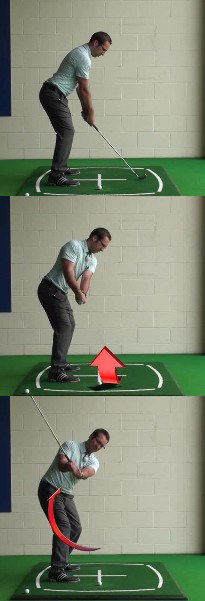
How to Correct a Flat Golf Swing
The shape of your golf swing plays a critical role in the shots that you are able to produce. Certain golf swings are better suited to produce certain shot shapes than others, so you need to make sure that you are using a swing that is in line with the shots you are trying to hit. If your swing is fighting against your vision for the shot, you will have very little chance of success. Give yourself the best possible chance to hit a good shot by picking targets that will allow you to shape the ball in a way which is compatible to your overall swing mechanics.
Generally speaking, swing shapes fall into two basic categories – flat and upright. A flat swing is one where the club stays lower to the ground and wraps around your back in the backswing. Many people like to think of this as a 'baseball style' swing, since the path of the club somewhat resembles that which a baseball player would use. On the other hand, an upright swing is one that lifts the club up toward the sky. The telltale sign of an upright swing is a high left arm position (for a right handed golfer) at the top of the swing. If the left arm is separated from the body significantly at the top of the swing, you can be sure that the swing will fall into the upright category.
This article is going to deal with flat golf swings – specifically, those that have gotten too flat. There are many great reasons to use a flat golf swing, and many of the best golfers in the world have used a flat swing to build their careers. However, if your swing gets too flat, you will start to notice a drop in the quality of your ball striking. There is a fine line between a flat swing and one that is too flat, so you will need to know how to look for the warning signs that a problem is developing in your game. As long as you can strike a good balance between flat and too flat, you should be able to consistently produce quality shots round after round.
It is important to correct any swing flaws that develop in your game as soon as possible to prevent them from become a major issue. If you allow swing mistakes to linger round after round for months, you will have a hard time breaking those new habits when you finally get down to work on fixing them once and for all. It is a much better strategy to confront these problems right away, spending the necessary time on the driving range to straighten out whatever it is that has gone wrong.
All of the instruction contained below is based on a right handed golfer. If you happen to play left handed, please take a moment to reverse the directions as necessary.
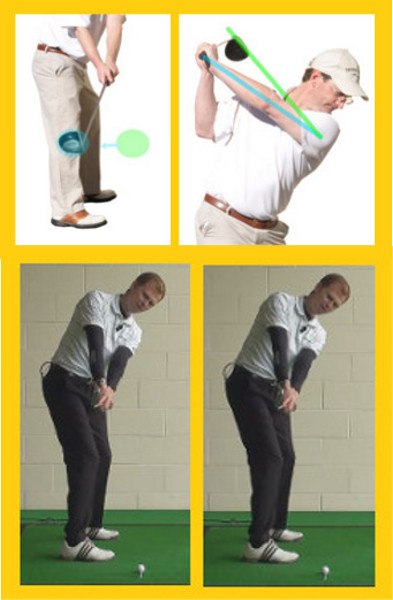
Do You Use a Flat Swing?
Before trying to fix your flat swing, you need to make sure you actually have a flat swing in the first place. It is common for amateur golfers to try and fix problems that don't exist, so you want to carefully evaluate your current technique before you go making any radical changes. If you do in fact find that you have a flat swing, and it has gotten too flat, you can then make the appropriate adjustments to get back on track.
The best way to evaluate the shape of your current golf swing is to record it on video. It is simply too hard to get a clear view of your swing while you are making it to make any confident determinations. Instead, ask a friend to help you out by recording your swing on video with a cell phone (or other video recorder). It should only take a couple moments on the range to get some good video, and you can use that video to decide how you need to proceed with your swing technique.
For the purposes of determining whether your swing is flat or upright, you will want to record your swing from the 'down the line' angle. That means that the person recording the video should be standing a safe distance behind you, on an extension of your target line. This is the angle that you most-often see when you watch golf on TV, and it will give you a perfect view of the current state of your technique. In addition to looking at the shape of your swing, you can also use this video to spot any other errors that need to be corrected.
Once you have the video recorded and you get a chance to watch it back, the first thing you should do is pause one of the swings at the top so you can check your arm positions. When your swing transitions from backswing to downswing, stop the video and note the position of your left arm relative to the rest of your body. Can you see your right shoulder above your left arm, or is your arm covering up that shoulder? If your arm is below the level of your shoulder, you can be confident that you are making a flat swing. On the other hand, if your arm is covering your shoulder – or if it is even higher – you are in the territory of an upright swing.
It really is that simple. Compare your left arm to your right shoulder in the video and you will know instantly if your swing falls into the flat category. It is important to note that you won't necessarily be able to tell if your swing has gotten 'too flat' just by watching the recording. To make that determination, you will have to rely on the results of your shots on the course. For now, you are only trying to figure out if you do in fact use a flat planed swing. From there, you can move forward into addressing any specific problems that might need to be fixed.
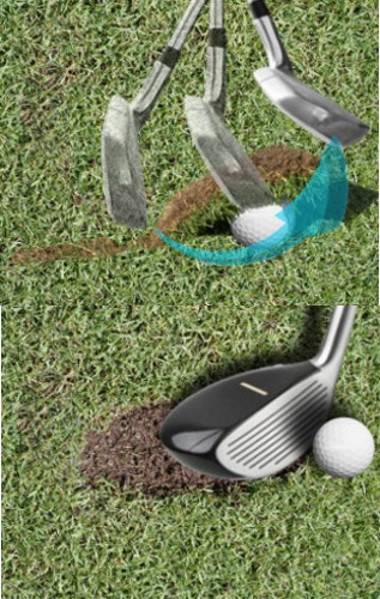
Signs of Trouble
As mentioned above, you aren't really going to be able to tell if your swing is too flat just by watching the video. Along with the video, you will need to watch for signs of problems within your game. Most likely, you have already started to notice these issues as they popped up during recent rounds on the course. Any change to your typical ball flight should be cause for concern, as the ball flights that you generate are a direct result of the swing mechanics that you use. The ball won't start flying in a different direction on its own – it is only going where you tell it to go. If you aren't happy with the current direction of your shots, you will want to check to make sure a flat swing plane isn't the underlying culprit.
When any of the following three shots begin to appear in your golf game, you might want to consider the idea that your swing plane has become too flat to be effective.
- Fat shots. One of the first signs of a backswing that is too flat is hitting the ball fat on a regular basis. When you come down into the turf before your club reaches the ball, you will hit the shot fat and the ball will come up short of the target. This can occur in a flat swing simply because you run out of room between your club and the ground before you ever get to impact. Flat swings use a shallow angle of attack to hit the ball, which is normally not a problem, but that shallow angle can lead to fat contact if your swing dips a bit from its normal position. If you are consistently hitting the ball fat and you can't figure out why, check to make sure that your backswing hasn't flattened out too much.
- Pushed shots out to the right. It is easy to get frustrated with your game if you feel like you are hitting the ball solidly – only to look up and see the shot sailing out to the right of your target. Pushing the ball directly to the right of your target is a sure sign that the club face is open at impact, meaning you need to rotate faster in the downswing in order to get squared up. Unfortunately, if your backswing is too flat, you won't be able to square up in time because the club will have a long journey to make all the way around your body. Even if you do everything else right in the downswing, you might not be able to recover in time to hit the ball on line with your target. By raising the height of your backswing by just a few inches, you will actually give the club a much better chance of reaching a square position at the bottom.
- High, weak ball flights. Every golfer knows just how important it is to hit the ball with a strong, penetrating flight. When the ball comes off of your club face like a rocket, you feel like you can hit through wind without much of a problem at all. However, when the ball starts to float off of your club, it is a different story entirely. With a weak ball flight, your shots float off line easily, and they often come down short of the target. This can happen when you scoop the ball at the bottom of the swing – which often is caused by an extra-flat backswing. Coming in from a shallow angle may eliminate your ability to hit down on the ball, meaning you will scoop through impact and send the ball high into the sky. Hitting down on the ball will help you add backspin and will also lower your launch angle, both of which are good things when it comes to producing a powerful flight.
If you are currently pushing the ball to the right, hitting the ball fat, or hitting weak shots high into the air, your backswing may have dipped too far down at the top of the swing. Each of these three problems will make it difficult to shoot good scores, so getting this problem fixed as quickly as possible is important to the quality of your game.

Making the Adjustment
Once you have made the determination that your backswing is indeed too flat, the next thing you need to is decide how you are going to fix it. It might sound easy to just raise the level of the club at the top of the swing, but your habits are going to want to keep pulling you into the same position. Instead, you need to have a very specific plan in place for how you are going to find the new position. This plan should have actionable steps that you can follow on the driving range in order to alter the shape of your swing.
For most golfers, making the move to raise the backswing level is going to be a two-step process. Each of these two steps is critically important to the success of the swing change overall, so don't make the mistake of overlooking one in favor of the other. Work on both of these points on the range and your swing should be back on track in the very near future.
- Set your wrists earlier in the swing. The action of setting your wrists will act to raise the level of the golf swing as soon as you start that motion. Players who use upright swings tend to set their wrists very early in the backswing, while flat plane swingers wait until the very last moment – if they even set them at all going back. While you don't have to move your set all the way down to the takeaway, you will want to complete this action earlier in the backswing in order to give your swing a little bit of height. As a good rule of thumb, you should start your wrist set as soon as your left arm is parallel to the ground in the backswing. Of course, that doesn't mean that your wrist set will be complete at that point. If you start it when your left arm is parallel to the ground, that wrist set should be comfortably complete by the time the club reaches the top of the swing. Experiment with this timing until you find a wrist set position that is comfortable and gives you the results you are looking for in terms of ball flight. As you work on this tip, make sure you don't get too 'handsy' early in the swing, or you will completely change the way the club moves around your body. Keep your takeaway exactly the same, and engage your wrists about halfway back to give your backswing the lift it needs.
- Keep your chest over the ball. One of the common mistakes seen in the swings of many amateur golfers is the tendency to move the upper body back away from the ball during the backswing. At address, you setup with your chest tilted out over the ball and your knees bent nicely. However, after the swing starts, you might be tempted to stand up out of that posture, straightening your legs and losing the tilt in your upper body. This is a problem for a variety of reasons, but specifically it will cause your backswing to get flatter because you will no longer have some built in elevation with the tilt in your upper body. Losing your tilt will cause your arms to drop, and you will be left with a very flat backswing that has almost no chance of hitting down on the ball through impact. On the driving range, focus on holding your posture throughout the swing, from the moment the club starts in motion until you are holding your finish position. Posture and balance are crucial to playing good golf, so make sure you are staying down throughout the backswing phase of the swinging motion. With your chest over the ball and your knees flexed, it will be far easier to put the club in a good position at the top.
The good news in this article is that each of these points should be relatively easy to practice. Simply by adding some wrist set earlier in your backswing, and focusing on holding your posture, you can get on a better plane and hit better shots. Of course, as you already know, improvement in golf never comes easy. If you are going to successfully work these tips into your swing, you are going to have to invest the necessary time and effort on the range. For those who are willing to work, however, the reward will be an effective golf swing that holds up from the first tee to the last green.
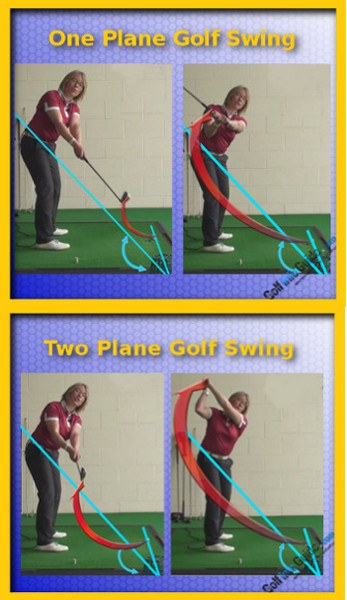
Staying on Track
With your swing plane corrected, you should be hitting some good shots and playing some good rounds of golf. That's great news – but how do you keep it going? If your swing dropped down too low once, what's to prevent that from happening again? While your golf swing will always be a work in progress, there are some things you can do to hopefully stay on the right plane from now one.
The first thing you need to do is have the right mindset when you are hitting golf shots. Anytime you have an iron in your hands, you want to be thinking about hitting down on the ball. With the possible exception of a shot played from a fairway bunker, you always want to be hitting aggressively down through the ball at impact. By thinking about hitting down, you will be telling your body to stay over the shot and swing down from a higher hand position at the top. Just that simple mental message alone may be enough to prevent you from falling into bad habits. Players who start to think about helping the ball into the air by scooping it at the bottom will always be susceptible to making a flat backswing.
Another way to monitor the quality of your backswing is simply to record yourself on video from time to time. If you can check in on the shape of your swing once every couple of months, you should be able to catch any developing problems before they get too serious. If you only notice a problem in your swing when you start to hit bad shots on a regular basis, you are already pretty far along in the process. Get into the habit of asking someone to record your swing every few weeks at the driving range and it should be much easier to avoid any problems.
Finally, you can stay on top of your game simply by practicing more frequently. If you only hit balls once per month or so, it will be easy for your body to 'forget' the right way to swing the club. If you have the opportunity to hit balls at least once per week, you can build up the kind of habits that are needed to hit good shots consistently. By perpetually working on the positions in your swing, you may never have the chance to fall into bad habits in the first place.
There is nothing wrong with a flat backswing. In fact, many golf teachers would argue that it is better to play from a flat plane than an upright one. However, when that swing plane gets too flat, bad things will start to happen on the course. Work on raising the level of your hands at the top of the swing – even if only by an inch or two – and you can quickly get your game going in the right direction once again. Letting swing problems fester will only allow them to turn into even bigger issues, so use the content above to solve this swing fault as quickly as you can.






